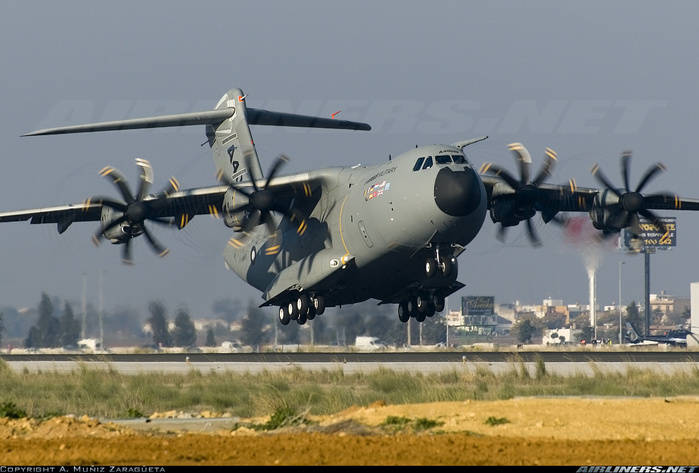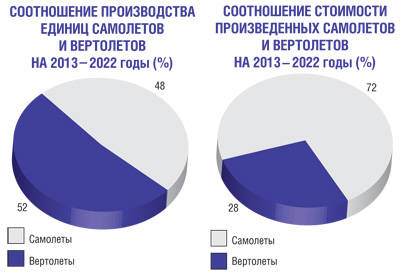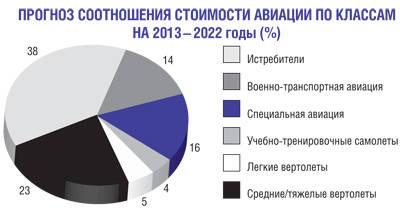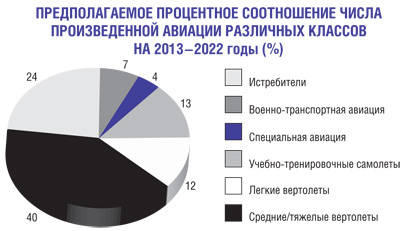Military aircraft production will decline
The US analytical agency Forcast International (Forecast International - FI) predicts that in the next ten years, the production of military aircraft will be reduced, mainly European and American products. The fact is that current products of the military-industrial complexes of developed countries have reached a high level of price, quality and ability to perform a wide range of tasks, moreover, they are easily modernized, so large production volumes are not required. And the total cost of the aircraft will exceed that of helicopters.
According to FI forecasts, the 2013 2022 11 military aircraft worth 940 billions of dollars in the world will be produced from 480 to 2014 year. Annual output will reach the maximum value in 1367-m - 1095 units. This will be followed by a reduction in production to 2018 units in the 1122 year and a slight increase to 2020 units in the 2022 units. After that, the decline to the 35 year is again expected. However, it is noted that the implementation of such new projects as the F-2 Lightning 400 (Lightning II) manufactured by Lockheed Martin and AXNUMXM of Airbus (Airbus) will not be difficult.
Fighters and transporters
In general, until 2022 fighters will make up most of the produced aviation both in quantity and in cost. FI experts believe that 2900 vehicles worth a total of $ 183 billion will be produced during the period. The peak of production will be in 2022 and will amount to 355 units, but in the coming years it will go at a relatively small pace.

Unlike their predecessors of the Cold War period, modern fighters are more reliable, the modernization process is much easier, and the range of tasks performed is much wider, so the number can be reduced without compromising combat capability. In other words, there is no need to simultaneously operate a highly specialized fighter-interceptor and attack aircraft, if they are easily replaced by one multifunctional machine. In addition, the increased cost of aircraft does not allow most nations to purchase them in large quantities.
The largest fighter aircraft manufacturers in 2013 – 2022 will remain Boeing, Eurofighter consortium, Dassault, Saab, Chengdu and Russian United Aircraft Building corporation (KLA). It is assumed that models of cheap fighters of the Indian HAL and South Korean KAI will not have significant export potential.
The attention of specialists is currently focused on the development of the F-35 “Lightning-2” program. The aircraft will go into service with the United States and several European countries. In October of this year, the United States Department of Defense and Lockheed Martin signed a contract for the supply of Lightning 71 for 6 and 7 for the main 8,3 billion dollars. This transaction is an important milestone in the creation of F-35 and the result of the efforts of the Ministry of Defense and manufacturers to reduce production and procurement prices.
The total cost of 36 aircraft 6 th party and the cost of their production has reached 4,4 billion dollars. Changes in the production of the F-35 7 head aircraft have reduced the cost of one aircraft by an average of six percent compared to the 5 batch.
Now 71 machine head batches is in varying degrees of readiness. Lockheed Martin will begin deliveries to customers in the middle of the 2014 of the year (6-lot) and will continue in a year (7-lot). The first to get them are Italy and Australia, and in the 2015 year - Norway. The contracts stipulate in advance that the company will cover all production costs.
 The supply of engines for the F-35 is regulated by a separate contract between the US Department of Defense and Pratt & Whitney. The terms of the new agreements are more beneficial for the Pentagon, as they shift most of the responsibility in the event of non-performance of the contract to Lockheed Martin.
The supply of engines for the F-35 is regulated by a separate contract between the US Department of Defense and Pratt & Whitney. The terms of the new agreements are more beneficial for the Pentagon, as they shift most of the responsibility in the event of non-performance of the contract to Lockheed Martin.According to Forcast International, the total cost of an 71 aircraft will be 8,3 billion dollars. That is, one machine will cost an average of 116,9 million, excluding the engine. The sum also does not include the contracts that preceded the production of 6 and 7 of the leading parties.
Analyzing the proposed development of military transport aviation (BTA), agency experts believe that in the 2013 – 2022 years in the world 848 planes will be built with a total value of 66,9 billion dollars. Due to the mass production of heavy A400M in 2018-m peak is possible - 102 units. This model is likely to be up to 25 percent of the total production of military transport aircraft. Its competitor will be Boeing’s C-17.
On the market of tactical military vehicles, the main models will be C-130J Lockheed Martin, the tactical version of the Airbus A400M and KC-390 of the Brazilian company Embraer. The latest car attracts the special attention of experts, as the company has achieved the most impressive progress among global manufacturers. In the coming years, more 700 new medium-sized transport aircraft will be needed, and Brazilians expect to take about 15 percent of the market.
Special and educational aviation
Airborne early warning, ground and sea detection aircraft, tankers will be produced according to forecasts in the number of 538 units with a total value of 78,1 billion dollars. Approximately half of them will be made by Boeing products - the KC-46A tanker and the P-8A Poseidon anti-submarine / patrol aircraft, which will replace the outdated Orion P-3. Poseidon is also looking forward to the international arms market. And experts consider the supply of KC-46A for the USAF to be one of the most important market factors in the near future.
 In February, 2011-i Boeing won a tender in a tense struggle with the European company ЕАДС (EADS), which presented the aircraft on the basis of the civil Airbus A-330. The contract was estimated at 4,9 billion dollars, it includes the development of the aircraft and the production of the first batch. It is expected that American aircraft 18 aircraft will get to 2017 year.
In February, 2011-i Boeing won a tender in a tense struggle with the European company ЕАДС (EADS), which presented the aircraft on the basis of the civil Airbus A-330. The contract was estimated at 4,9 billion dollars, it includes the development of the aircraft and the production of the first batch. It is expected that American aircraft 18 aircraft will get to 2017 year.A critical analysis of the project lasted 10 months and was the first important stage in the implementation of the contract with a firm payment of the cost of work and incentive pay. The customer representatives prepared his 21 August 2013, which is a month ahead of schedule. The Air Force came to the conclusion that it would not be necessary to launch major changes in the series, although the design of the prototype revealed six serious flaws. Four of them, according to the customer, must be eliminated in the drawings. The remaining two are interruptions in KC-46 communications with the command center of the tanker aircraft (Air Force Tanker Airlift Control Center), as well as operating at maximum power for ten minutes without subsequent ground repair. The leadership of the Air Force considered: both problems can be eliminated without much effort. So the contract will be executed by 2017, with a probability of 90 percent, FI analysts write. At the time of the critical analysis, the development of the aircraft was completed at 40 percent.
At the same time, representatives of the customer expect the greatest difficulties at the stage of joint tests of the KS-46. This requires synchronizing the efforts of the company, the Air Force and the United States Federal Aviation Administration (FAA), so as not to duplicate the tests. The fact is that the KS-46 is created on the basis of the civilian airliner Boeing-767-2С. Its first flight is scheduled for July 2014. He, in the form of an air tanker, is supposed to take to the air in January of the 2015.
By the middle of 2013, the Pentagon had funded a project worth 2,2 billion. At the same time, the Air Force is developing its own concept of servicing fueling aircraft, different from that offered by the supplier. The theoretical part will be completed by 2015, and as the KS-46 comes on line in 2017, its implementation will begin.
As for the training aircraft (TCB), they are expected to be about 1,5 thousands of units with a total value of 18,5 billion dollars. It is likely that, before 2015, the production of TCB will increase from 186 to 200 machines, then the industry will experience a sharp decline. This is due to the completion of procurement by the US Department of Defense Turboprop T-6 "Teksan-2" (Texan II). The smallest issue FI experts expect in 2022 year - 97 units. Then a new rise in production is possible in connection with the adoption of the jet TX, which will replace the outdated T-38. In total, US aviation is ready to buy 350 TX aircraft.
Helicopters
Production of light helicopters weighing up to 6804 kilograms, which has recently grown rapidly, will soon slow down. Before 2022, 1425 will be released for 23,3 worth billions of dollars. The medium / heavy helicopter segment, i.e., over 6804 kilograms, will suffer more. If 623 machines are built this year, the production decline will last at least until 2018. Total medium / heavy helicopters will launch 4728 units worth 110,5 billion dollars.
 Special attention is paid to the export of American medium and heavy helicopters, as national manufacturers join forces in foreign markets. The US government is also developing Foreign Foreign Sales (FMS), a program of military aid to foreign countries, which coordinates the promotion of AH-64E Apache and CH-47F Chinook and Black Hoke UH-60M Sikorsky’s models in the world of Boeing. ". According to analysts, sales of the Apache and Chinooks represent a significant percentage of US military exports.
Special attention is paid to the export of American medium and heavy helicopters, as national manufacturers join forces in foreign markets. The US government is also developing Foreign Foreign Sales (FMS), a program of military aid to foreign countries, which coordinates the promotion of AH-64E Apache and CH-47F Chinook and Black Hoke UH-60M Sikorsky’s models in the world of Boeing. ". According to analysts, sales of the Apache and Chinooks represent a significant percentage of US military exports.CH-47 are in service with 18 states. Additional supplies are planned in 11 of them, and in addition, exports to four more countries. Thus, Boeing will sell about 150 Chinook under the DCS (Direct Commercial Sales) commercial delivery program and through the state FMS. Apache is supplied to 12 states, and the number of consumers will soon increase due to India and South Korea. It is possible that Indonesia will order eight AH-64.
The Boeing helicopter unit is one of the most efficient and stable in the company. This is facilitated by the practice of long-term contracts. The company's management believes that well-being will continue for at least five years, during which it is necessary to lay the foundation for further growth, mainly to strengthen cooperation with the US Army. The production of CH-47F for the national armed forces will be completed by 2019, and then the delivery of its improved version of the “2 unit” will begin. All US Army helicopters will be refined to this standard. At the same time, a further increase in exports is expected. Now "Boeing" sells abroad to 55 machines per year. By 2020, this number will be 40 units, but already in 2023, the demand for the upgraded version of Chinook will increase to 70.
The current CH-47 model is implemented using DCS and FMS programs. The DCS provides for the modernization of already operated helicopters and the provision of additional equipment to them. For example, the modified CH-47F of Canada has a new set of avionics in the cabin and a power supply system based on two 60 kW electric generators. And the CH-47 Mk6, supplied to the UK, is equipped with a Thales-manufactured cabin that will allow them to be used together with the Chinooks already existing in the British Army. There is a possibility of supplying these machines to Libya, Turkey, Saudi Arabia, Qatar, Morocco, Egypt and the United Arab Emirates.
After upgrading the AH-64 "Apache" to the version of the "block-3", its sales in the international market also increased. One of the reasons for this is orders for the supply and modernization of the machines already in service with the states of the Middle East. Saudi Arabia intends to become the second country in the number of purchased AH-64E, adopting this type of arming the army, national and royal guards. UAE has requested 30 retrofit kits for their AH-64D and 30 new machines.
Further development of the export potential of the helicopter may increase the demand for the supply of 24 machines from Qatar. South Korea also placed an order for 36 AH-64E as part of its heavy attack helicopter purchase program. Another 22 helicopter will be shipped to India, and eight are requested by Indonesia. Boeing has already completed the Apache delivery of the 3 version for the Taiwan Army.
Most of these contracts are implemented through the FMS program, since the states that placed the order for AH-64 have fairly close ties with the American army. Boeing also offers its product for export through the commercial DCS system, but a number of its systems and weapons must be supplied under the FMS program.
Sikorsky also offers to export its Black Hawk UH-60M via FMS and DCS. Bahrain, Mexico, Sweden, UAE, Saudi Arabia purchased these machines. The Defense Cooperation Cooperation Agency (DSCA) intends to deliver them under the FMS program in Qatar, Taiwan and Thailand.
The growth in the production of medium / heavy helicopters after the 2022 year is possible in connection with the implementation of the FVL (Future Vertical Lift) advanced vehicle project. Analysts believe that the new FVL helicopters will be put into service by 2030.
Information